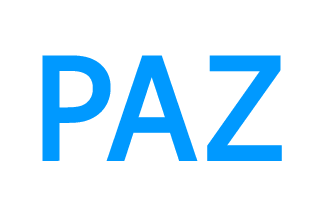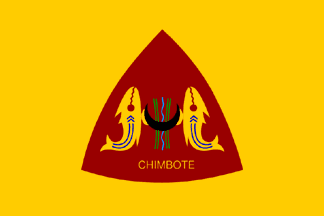
image by António Martins-Tuválkin, 09 December 2010

Last modified: 2021-08-25 by rob raeside
Keywords: santa | chimbote | flores g. (carmela) | fishes: 2 (yellow) | crescent: points up (black) | triangle (brown) | moxica |
Links: FOTW homepage |
search |
disclaimer and copyright |
write us |
mirrors

The flag of Chimbote is yellow with the arms
in the middle; it has been used since 1981. (Source:
PressPeru)
Ivan Sache, 07 Jan 2007
According to the Spanish
Wikipedia, the city flag of Chimbote is ~2:3 golden yellow with an emblem
on its center. The emblem is a brown equilateral triangle pointing up, with
sides bulging outwards, picturing two stylized golden yellow fish with dark
blue wavy line ornaments, posed as heraldic supporters holding a small black
crescent pointing upwards on three verical wavy stripes, the middle one being
blue and slightly larger and the other two being green and made of two close
lines; below all this the word "Chimbote" in sans-serif golden yellow
capitals.
António Martins, 28 Oct 2007
On 5 December 2006, the Peruvian Press Agency Pressperu reported that for the first time in the history of the National Parliament the flag of Chimbote was hoisted on Plaza del Libertador Simón Bolívar in Lima. The hoisting, supported by the Representative from Chimbote María Helvezia Balta Salazar, celebrated the 100th anniversary of the foundation of the town. The Peruvian national flag was first hoisted,as done every Monday in the traditional patriotic ceremony, and then the flag of Chimbote was hoisted.
(There is no picture of the flag but a description of the flag, which is, word by word, taken from the municipal website, therefore describing the elements of the shield in full colours.)
(Source:
PressPeru)
Ivan Sache, 07 Jan 2007
The coat of arms was designed by Carmela Flores G., winner of a contest set up by Mayor Guillermo Balcázar Rioja. The adoption date is 7 October 1966. The symbol is made of two stylized fishes gold and blue, after an old Mochica representation, which symbolize the wealth of the city due to fishery. The Mochica culture flourished in northern Peru from 100 to 700 AD.
The two fishes support a black half-moon, representing by its shape the greatest Mochica deity and by its colour the mineral resources that allowed industrialization of Chimbote. The moon is placed on a vertical wavy blue stripe representing river Santa, flanked on each side by two totora stems, the whole representing the valley fertilized by the river. Totora (from Quechua, "tutura") is the sedge Schoenoplectus californicus (C. A. Mey.) Soják, whose stems are used to make the caballitos de tortora, the traditional boats used by fishers on the northern Peruvian coast and on Lake Titicaca.
On the image shown on the municipal website, all the elements of the coat of arms are indeed represented in yellow, the whole being placed on a dark red field. The shape of the coat of arms is a convex triangle with a black borderThe design is marked with a "©", which seems to indicate it is official.
(Source:
PressPeru)
Ivan Sache, 07 Jan 2007
The town of Chimbote (c. 500,000 inhabitants) is a port town located in northern Perou and capital of the Province of Santa, Department of Ancash, 412 km north of Lima.
In his article "La Provincia del Santa en la Historia" (The Province of Santa in history), Augusto Alba claims that "the industrial port of Chimbote was named in the past Ferrol", as shown on the "América Delineata" map, published in 1636. Chimbote was mentioned for the first time in 1774 by Cosme Bueno in his "Introducción y Descripción de las Provincias pertenecientes al Arzobispado de Lima" (Introduction and Description of the Provinces depending of the Archbishopric of Lima). Bueno wrote: "la antigua Villa de Santa María de la Parrilla (Santa), tiene anexo un pueblecito de pescadores nombrado Chimbote" (the ancient town of Santa Maria de la Parrilla has for dependency a small fishers’ village named Chimbote). In his famous "Diccionario Geográfico de Indios" (Geographic Dictionary of the Indies), published in 1786, Antonio de Alcedao described Chimbote as a rock or islet of the Southern sea on the coat of Peru, in the Province and Corregidorate of Santa, close to another rock named Corcovada.
The historian Antonio del Busto believes that the name of Chimbote appeared in the beginning of the XVIIth century and is of Japanese origin. Several fanciful etymologies have been proposed for Chimbote, for instance "pueblo sin bote" (village without boats), referring to the difficulty of disembarking in the port. The word Chimbote most probably comes from "chimba" and "bote". According to Gonzales Holguin’s Quechua lexicon, published in 1608, "chimbo" means "the other part of the river"; "bote" is a small boat with rows. A similar explanation given in the book Chimbote a través de la Historia (Chimbote in history) relates "chimba" to the Quechua word "chimpay", "to go to the other bank".
On 12 August 1813, the priest Manuel Castellanos released the Padrón de Vecinos de Villa de Santa y Ranchería de Chimbote (Census of the inhabitants of the town of Santa and the Camp of Chimbote), where the first known 25 inhabitants of Chimbote are listed.
On 1 January 1872, Chimbote was granted the title of Main Port (Puerto Mayor), following a Supreme Decree signed by President José Balta on 9 December 1871. On 23 January 1872, another Supreme Decree confirmed the proposal of building of a village on the domain owned by Juan Gilberto Meiggs. The village later increased and formed the today’s town of Chimbote. The railway was inaugurated in Chimbote on 12 February 1872. On 27 November 1895, the Congress of the Republic passed a Law changing the name of "pueblo de Chimbote" (village) to "Villa de Chimbote" (town); the Law was signed by President Nicolás de Piérola on 4 December 1895. Accordingly, the seat of the capital of the District of Santa was transferred to Chimbote. On 5 December 1906, Law No 417 separated the District of Chimbote from the District of Santa; the law was signed by President José Pardo on 6 December 1906. The new district was made of he port of Chimbote and the surrounding pampas On 14 April 1950, following the increase of Chimbote, the Province of Santa was divided into two new provinces, the Province of Santa, with Chimbote as its capital, and the Province of Huarmey, with Casma as its capital. The new Province of Santa included the Districts of Cáceres del Perú (capital, Jimbe), Chimbote (capital, Chimbote), Moro (capital, Moro), Nepeña (capital, Nepeña), Macate (capital, Macate) and Santa (capital, Santa). The District of Chimbote has 249,347 inhabitants and an area of 1,461 sq. km.
Chimbote was partially destroyed in 1970 by a huge earthquake. In the same time, a big bloc of ice fell down from the Huascarán volcano into the Llanganuco laguna, causing a flood by water containing stones and earth, nearly destroying the town of Yungay and killing most of its 30,000 inhabitants. Some 3,000 of them could escape to higher lands before the flood. The official toll was 30,000 in Yungay, Caraz and Ranrahirca, 10,000 in Huaraz, 2,700 in Chimbote, 2,000 in the province of Bolognesi, 1,000 in Huarmey and 70-150 in other, unspecified villages.
In the 1970s Chimbote was one of the biggest fishing ports in the world, with more than 30 factories. The earthquake, as well as overfishing and the El Niño climatic events drastically affected the fishing industry.
(Source: Municipal website)
Ivan Sache, 07 Jan 2007

image by António Martins-Tuválkin, 09 December 2010
Since 1993, the municipal administratrion of Chimbote also flies a
peace flag, white with the word "Paz"
(Peace) in blue. (Source:
PressPeru)
Ivan Sache, 07 Jan 2007
An equivalent newsreport with photo is (for now) available at
http://noticiario.baguaperu.com/2009/07/espectacular-concentracion-en-siempre.html
showing the described flag in use in 2009 in Bagua, Peru. The letters are
all upper case, in a simple serifless face.
António Martins-Tuválkin, 09 December 2010